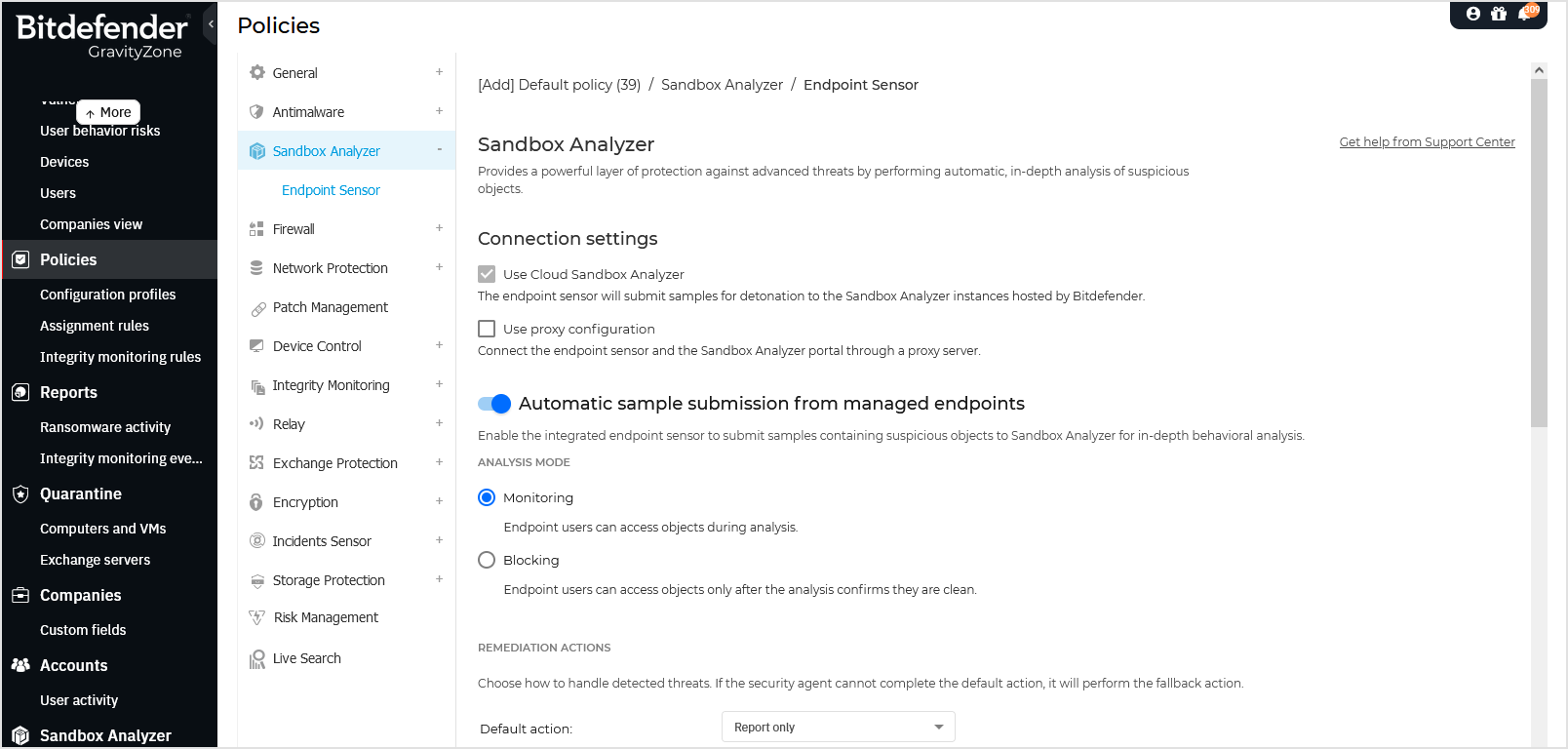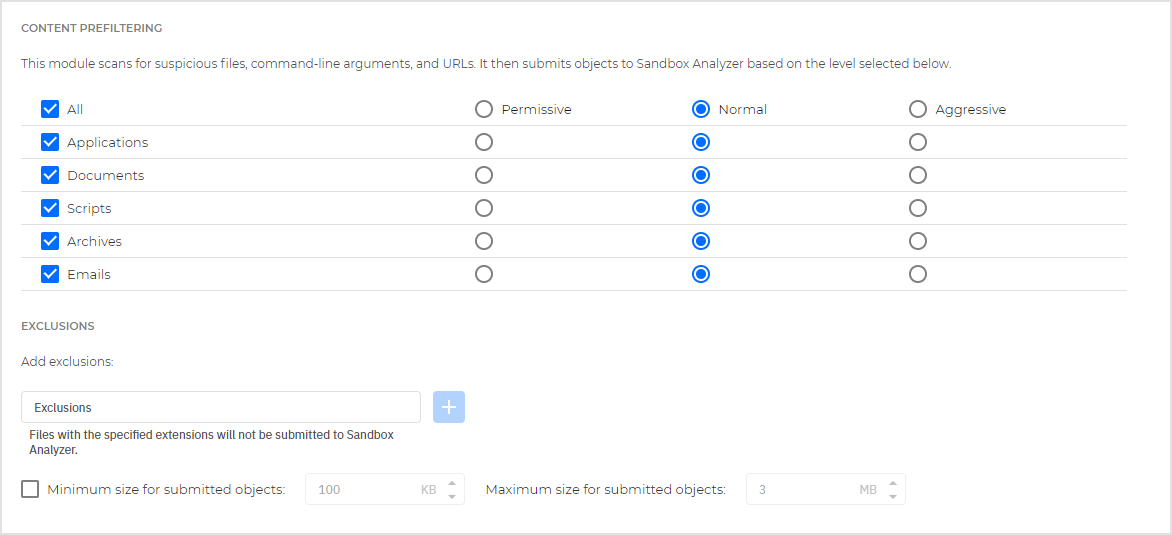Sandbox Analyzer
Sandbox Analyzer provides a powerful layer of protection against advanced threats by performing automatic, in-depth analysis of suspicious files that are not identified by Bitdefender antimalware engines yet.
Note
This module is available for:
Windows for workstations
Windows for servers
Manual submission to Sandbox Analyzer is supported on Linux endpoints as well. However, these policy settings affect only automatic submissions and therefore, are not relevant for Linux endpoints protected by BEST.
Endpoint Sensor
Bitdefender Endpoint Security Tools can act as a feeding sensor for Sandbox Analyzer that automatically submit suspicious samples from Windows endpoints.

To configure the Sandbox Analyzer settings for automatic submission, go to the following sections:
Connection settings.
The endpoint sensor is configured to submit samples to a default Sandbox Analyzer instance hosted by Bitdefender, depending on your region.
If you have your network behind a proxy server or a firewall, you can configure a proxy to connect to Sandbox Analyzer by selecting the Use proxy configuration check box.
You have to fill in the following fields:
Server - Enter the IP address or the hostname of the proxy server.
Examples:
IP address:
198.51.100.10Hostname:
proxy-example.comNote
Do not use formats such as
http://proxy-example.comorproxy-example.com:8080. These are invalid.
Port - Enter the port number used to connect to the proxy server. Examples:
8080or3128.Username - Enter the username authorized to access the proxy server.
Password - Enter the corresponding password for the specified user.
Sandbox Analyzer supports local file submission through endpoints with relay role, which are able to connect to different Sandbox Analyzer Portal addresses depending on your region. For details regarding the relay configuration settings, refer to Relay.
Note
A proxy configured in the Sandbox Analyzer connection settings will override any endpoints with relay role.
Enable the Automatic sample submission from managed endpoints option. If you want to manually submit a sample, refer to Manual submission.
Important
Sandbox Analyzer requires on-access scanning. Make sure you have the Antimalware > On-Access module enabled.
Sandbox Analyzer uses the same targets and exclusions as defined in Antimalware > On-Access. Review carefully the On-Access scanning settings when configuring Sandbox Analyzer.
To prevent false positives (incorrect detection of legitimate applications), you can define exclusions by various criteria such as file name, extension, and path. For more information on exclusions, refer to Antimalware Configuration.
In addition to exclusions defined in the Antimalware section, you can specify them on this page as well, in the Exclusions field, as described further below.
The upload limit for any file or archive is 50 MB.
Choose the Analysis mode. Two options are available:
Monitoring. The user can access the file during the sandbox analysis, but he is recommended not to execute it until receiving the analysis result.
Blocking. The user cannot access the file until the analysis result is returned to endpoint from Sandbox Analyzer Cluster via Sandbox Analyzer Portal. The result should indicate the file is safe.
Specify the Remediation actions. These are taken when Sandbox Analyzer detects a threat. For each analysis mode you are provided with a default action.
When accessing this section for the first time, the following actions are available:
In the Monitoring mode, the default action is Report only.
In the Blocking mode, the default action is Move to quarantine.
Note
As best practice, it is recommended to use remediation actions in this configuration.
Sandbox Analyzer provides you the following remediation actions:
Remediate: Deny access to the infected objects, move them to quarantine and make an attempt to disinfect the system them by removing the malware code and the artifacts created by the malware. In disinfection is not possible, the infected objects are deleted.
Move to quarantine: Move infected objects from their current location to the quarantine folder. Quarantined objects cannot be executed or opened; therefore, the risk of getting infected disappears. You can manage quarantined objects in the Quarantine page of Control Center.
Report only: Sandbox Analyzer only reports detected threats without taking any other action on them.
Note
Depending on the default action, a fallback action may be unavailable.
Under Content prefiltering, customize the protection level against potential threats. The endpoint sensor has embedded a content filtering mechanism which determines whether a suspicious file needs to be detonated in Sandbox Analyzer.
The object types supported are: applications, documents, scripts, archives, and emails. For more details on the supported object types, refer to Sandbox Analyzer objects.
Use the master switch at the top of the threats list to choose a unique level of protection for all types of objects, or select individual levels to fine tune protection.
Setting the module at a certain level will result in a certain number of submitted samples:
Permissive. The endpoint sensor automatically submits to Sandbox Analyzer only the objects with the highest probability of being malicious and ignores the rest of the objects.
Normal. The endpoint sensor finds a balance between the submitted and ignored objects and sends to Sandbox Analyzer both objects with a higher and with a lower probability of being malicious.
Aggressive. The endpoint sensor submits to Sandbox Analyzer almost all objects, regardless of their potential risk.
Exclusions. In this field, you can define exclusions for the object types that you do not want to submit to Sandbox Analyzer
Submitted object size. To define size limits of the submitted objects:
Select the corresponding checkbox.
Enter any desired values between 1 KB and 50 MB.
